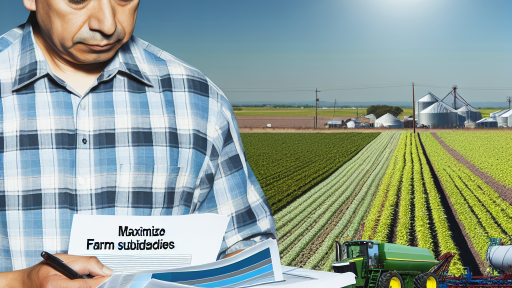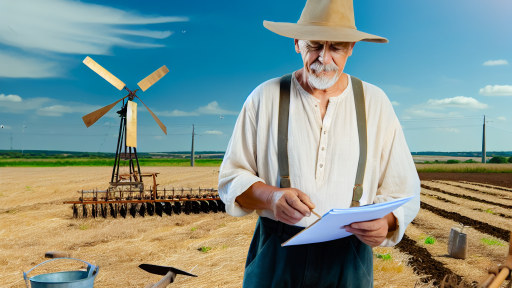Introduction to USDA Farm Subsidy Programs
The USDA farm subsidy programs play a crucial role in American agriculture.
They provide financial support to farmers to stabilize their income.
Additionally, these programs foster sustainable farming practices.
They help ensure a stable food supply for the nation.
Understanding these programs requires exploring their history and purpose.
History of USDA Farm Subsidy Programs
The origins of farm subsidies date back to the Great Depression.
During this period, the government aimed to support struggling farmers.
Over the years, these programs evolved to meet changing agricultural needs.
Significant legislation shaped the structure of farm subsidies.
Examples include the Agricultural Adjustment Act of 1933.
It marked the beginning of government intervention in farming.
Purpose of USDA Farm Subsidy Programs
These programs serve multiple purposes in the agricultural sector.
Firstly, they help mitigate the risks associated with farming.
Farmers face unpredictability due to weather and market fluctuations.
Additionally, subsidies promote crop production stability.
Transform Your Agribusiness
Unlock your farm's potential with expert advice tailored to your needs. Get actionable steps that drive real results.
Get StartedThey support farmers in choosing sustainable practices.
Finally, these subsidies strengthen rural economies across the nation.
Types of USDA Farm Subsidy Programs
- Direct Payments
- Counter-Cyclical Payments
- Production Adjustment Programs
- Crop Insurance
Each type has unique features that support farmers differently.
Direct payments provide fixed payments regardless of production levels.
Counter-cyclical payments kick in when prices fall below a certain threshold.
Production adjustment programs encourage farmers to limit crop production.
Crop insurance helps safeguard farmers against losses due to adverse conditions.
Impact of Subsidies on Agriculture
Farm subsidies have a profound impact on agricultural practices.
They can enhance productivity and income stability for farmers.
However, critics argue subsidies can distort market prices.
Ultimately, the effectiveness of these programs remains a topic of debate.
History and Evolution of Farm Subsidies in the U.S.
The Early Beginnings
Farm subsidies in the U.S. trace back to the 1930s.
During the Great Depression, farmers faced immense economic hardships.
In response, the federal government began implementing subsidy programs.
The Agricultural Adjustment Act of 1933 marked a significant milestone.
This act aimed to boost prices by reducing agricultural output.
Post-World War II Developments
Following World War II, farming practices and technologies advanced.
The U.S. government aimed to ensure food security and stability.
Thus, they introduced more extensive subsidy programs.
The 1949 Farm Bill established permanent price supports for key crops.
This policy aimed to create a safety net for farmers.
Shifts in Policy and Economic Focus
The late 20th century saw significant changes in subsidy policies.
In the 1970s, the government shifted focus towards income support.
Farmers received payments based on historical production levels.
Showcase Your Farming Business
Publish your professional farming services profile on our blog for a one-time fee of $200 and reach a dedicated audience of farmers and agribusiness owners.
Publish Your ProfileThis shift helped alleviate financial burdens during tough seasons.
Modern-Day Subsidy Programs
Today, farm subsidies encompass a wide range of programs.
These programs include direct payments, crop insurance, and disaster relief.
For example, the Federal Crop Insurance program protects farmers’ incomes.
Additionally, the Conservation Reserve Program promotes environmental sustainability.
Current Debates and Future Directions
Debates regarding farm subsidies continue among lawmakers and stakeholders.
Critics argue that subsidies favor large agricultural businesses.
Supporters contend they are essential for maintaining food production.
Moving forward, the focus may shift towards sustainability and equity.
Ultimately, these programs will need adaptation to meet new challenges.
Types of USDA Farm Subsidy Programs
Direct Payments
Direct payments offer financial support to farmers regardless of market conditions.
These payments typically target specific crops, including corn and soybeans.
Farmers receive set amounts based on historical production levels.
This program aims to stabilize farm income during challenging times.
Additionally, direct payments provide predictability for farmers’ financial planning.
Crop Insurance
Crop insurance helps protect farmers against losses from natural disasters.
It covers a variety of risks, such as droughts, floods, and pests.
Farmers can choose between different insurance plans based on their needs.
This program encourages farmers to take necessary risks for crop production.
Moreover, crop insurance fosters financial stability in the agricultural sector.
Conservation Programs
Conservation programs promote environmentally friendly farming practices.
These initiatives focus on preserving natural resources and ecosystems.
Farmers receive incentives for adopting sustainable land management practices.
Examples include the Conservation Reserve Program and the Environmental Quality Incentives Program.
Ultimately, these programs enhance both farm productivity and environmental health.
Learn More: Financial Aid Options for Sustainable Farming
Eligibility Criteria for USDA Farm Subsidy Programs
General Eligibility Requirements
Farmers must meet specific criteria to qualify for USDA subsidies.
Eligible farms typically operate in the United States.
Additionally, applicants must demonstrate a genuine commitment to farming.
They must also follow standard agricultural practices.
Income and Production Limits
Income thresholds apply to ensure subsidies support those in need.
Eligible farmers must report their annual income accurately.
Production limitations may vary based on the subsidy program.
For instance, certain crops might have specific production caps.
Types of Farming Operations
USDA programs cater to various types of farmers.
Both large-scale and small-scale farms can qualify.
Moreover, organic and conventional farms are eligible.
Specific programs might focus on specialty crops or livestock.
Compliance with Agricultural Regulations
Applicants must comply with federal and state agricultural regulations.
This compliance ensures stable and responsible farming practices.
Showcase Your Farming Business
Publish your professional farming services profile on our blog for a one-time fee of $200 and reach a dedicated audience of farmers and agribusiness owners.
Publish Your ProfileThe USDA verifies adherence through various assessments.
Failing to meet these regulations can disqualify applicants.
Application Process
Submitting an application is crucial for accessing subsidies.
Prospective applicants should gather necessary documentation first.
The USDA provides resources for understanding the application process.
Moreover, timely submissions increase chances of approval.
Learn More: The Latest Agricultural Subsidies: What Farmers Need to Know
Application Process for Farm Subsidies
Overview of Farm Subsidies
Farm subsidies help support American farmers financially.
These programs promote agricultural productivity and support rural communities.
Understanding the application process is essential for farmers seeking assistance.
Eligibility Requirements
To apply, farmers must meet specific eligibility criteria.
First, they need to be engaged in agricultural production.
Also, they must demonstrate compliance with conservation requirements.
Finally, they must be in good standing with federal farm programs.
Gathering Necessary Documents
Documentation is crucial for a successful application.
Farmers should prepare financial records and business plans.
Additionally, they may need land ownership documents.
Tax returns and production records could also be necessary.
Completing the Application Form
Farmers can access application forms online or at local offices.
It is crucial to fill out the forms accurately and completely.
Applicants should pay attention to deadlines to ensure timely submission.
Each program may have specific forms, so verifying details is important.
Review and Approval Process
After submission, the application undergoes a review process.
Officials check for completeness and verify eligibility.
Farmers may need to provide additional information if requested.
Approval time can vary based on the program and the number of applications.
Receiving Subsidy Payments
Once approved, farmers will receive their subsidy payments.
Payments may be made in a lump sum or in installments.
Farmers should keep documentation of all payments received.
This documentation will be essential for future applications or audits.
Gain More Insights: How to Apply for Farm Subsidies Successfully

Impact of Farm Subsidies on Agricultural Production and Market Stability
Role of Farm Subsidies
Farm subsidies play a crucial role in shaping agricultural production in the United States.
They provide financial support to farmers, enabling them to produce vital crops.
Consequently, these subsidies help stabilize the agricultural market.
Encouragement of Production
Subsidies encourage farmers to maintain consistent production levels.
This financial backing ensures that farmers have resources to grow various crops.
As a result, it reduces the risk of crop failure due to economic pressures.
Examples of Key Subsidized Crops
- Corn is one of the most heavily subsidized crops in the U.S.
- Wheat also receives significant financial support.
- Other important crops include soybeans and cotton.
Market Stability
Farm subsidies contribute to market stability amidst fluctuating prices.
They act as a safety net for farmers during economic downturns.
This stability benefits consumers by providing a reliable food supply.
Showcase Your Farming Business
Publish your professional farming services profile on our blog for a one-time fee of $200 and reach a dedicated audience of farmers and agribusiness owners.
Publish Your ProfileImpact on Prices
Subsidies can help lower prices for consumers.
They also prevent drastic price increases during supply shortages.
In doing so, they enhance food security in the nation.
Challenges and Criticisms
Despite their benefits, farm subsidies face criticism and challenges.
Some argue they promote overproduction and environmental harm.
Furthermore, subsidies can disadvantage smaller farmers.
Environmental Concerns
Overreliance on subsidized crops may lead to monoculture practices.
Monoculture can harm biodiversity and soil health.
Moreover, it may result in higher pesticide and fertilizer use.
Economic Fairness
Critics highlight that subsidies mainly benefit large agribusinesses.
This can create inequalities in the agricultural sector.
As a result, smaller farmers may struggle to compete.
See Related Content: Understanding Agricultural Financial Aid Options
Controversies and Criticisms Surrounding Farm Subsidy Programs
Disparities in Distribution
One key criticism revolves around how subsidies are distributed.
Large agribusinesses often receive a significant portion of funds.
This results in smaller farms struggling to compete.
Consequently, disparities widen in rural economies.
Environmental Concerns
Another concern focuses on the environmental impact of subsidies.
Many subsidy programs incentivize crop production over sustainable practices.
This can lead to soil degradation and water pollution.
Farmers may prioritize short-term profits over long-term health.
Market Distortions
Subsidies can distort market dynamics significantly.
They may encourage overproduction of certain crops.
This overproduction can depress prices and hurt farmers in the long run.
Additionally, international trade can be affected by such policies.
Food Security Implications
The impact of subsidy programs extends to food security.
They may not effectively address the needs of food-insecure populations.
Instead, resources frequently flow to already prosperous sectors.
This raises questions about the overall efficacy of the programs.
Calls for Reform
In light of these issues, many advocate for reforming subsidy programs.
Proposals include redirecting funds to support sustainable practices.
Some suggest facilitating access to resources for smaller farms.
These changes aim to create a more equitable agricultural landscape.
Future of USDA Farm Subsidy Programs: Trends and Policy Changes
Emerging Trends in Farm Subsidy Programs
The USDA is adapting its farm subsidy programs to meet changing agricultural needs.
Technology adoption is becoming a significant focus in these programs.
Farmers are increasingly integrating precision agriculture techniques.
This shift aims to enhance efficiency and sustainability on farms.
Climate change is another driving factor behind policy adjustments.
Programs are now incorporating strategies for climate resilience.
Furthermore, there is a growing interest in supporting organic farming practices.
Showcase Your Farming Business
Publish your professional farming services profile on our blog for a one-time fee of $200 and reach a dedicated audience of farmers and agribusiness owners.
Publish Your ProfilePolicy Changes on the Horizon
Recent discussions in Congress indicate potential reforms to current policies.
Lawmakers are considering increased funding for alternative crops.
This could support farmers who diversify their production methods.
Moreover, there is a push for improved access to subsidies for smaller farms.
This approach aims to level the playing field in agricultural competition.
Stakeholders expect more transparency in subsidy distribution going forward.
Impact of Global Markets
Global market trends significantly impact U.S. farm subsidy policies.
Farmers face fluctuating prices due to international competition.
Consequently, the USDA may adjust programs to combat these challenges.
Trade agreements may also influence the direction of subsidy support.
Balancing local needs with global demands will be essential for policymakers.
Community and Stakeholder Engagement
Engaging local communities is becoming increasingly important for policy effectiveness.
The USDA is seeking input from farmers and stakeholders regularly.
Forums and workshops allow for collaboration on future subsidy designs.
This engagement can lead to customized solutions that meet specific regional needs.
Ultimately, empowering communities enhances the sustainability of farming practices.
Future Directions in USDA Farm Subsidy Programs
The future of USDA farm subsidy programs is evolving rapidly.
Expected changes will reflect technological advancements and environmental concerns.
By aligning policies with contemporary agricultural practices, the USDA aims to support farmers effectively.
Additional Resources
Rural Energy for America Program Renewable Energy Systems …
Market Access Program (MAP) | USDA Foreign Agricultural Service




